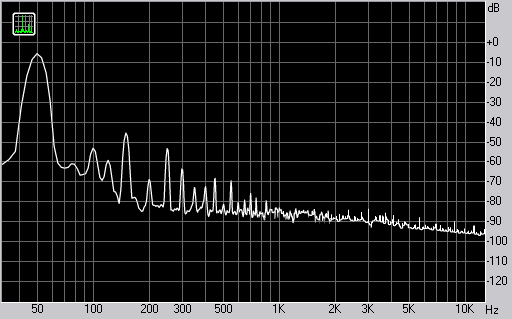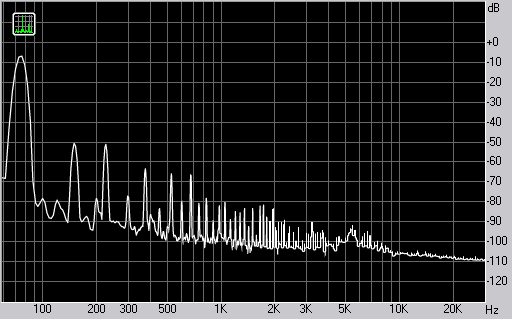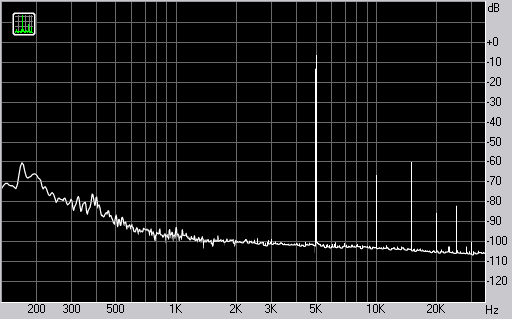 |
||
|
||
| ||
In October 2005 at AES 119 Convention E-MU introduced its first and still the only PM5 precision monitors, named, as you might have guessed, after "Precision Monitors" and their 5" LF speakers. PM5 distinctive features include class A preamp and output stage MOSFET. The monitor design is rather conservative. With their phase inverter slots E-MU monitors distantly resemble products by KRK. But they still have differences, including the less round edges. Monitors are rather compact measuring 17.5 x 29 x 20 cm. To isolate vibration the vendor supplies devices with self-adhesive rubber bumps. Each speaker weighs 6.5 kg. The monitors also feature soft dome tweeters acoustically pressed onto a flare. The dome diameter is 26 mm. The diameter of MF head dome is 11 cm with suspension. The dome itself is made of fiberglass. The flexible suspension is made of very soft rubber. Both speakers are magnetically shielded. Monitor back panel is made of metal. It features a heatsink and controls. Connections include balanced (via ÕLR combined interface and TRS jack) and unbalanced (RCA). Controls include a sensitivity knob, LF and HF cutoff frequency switches, and a power switch. The blue power LED is located on the front panel. Now let's proceed to RMAA measurements. First, let's see the AFC (amplitude-frequency characteristic) graph obtained by playing the swept sine. All measurements were conducted with the RightMark Audio Analyzer PRO suite. All measurements are conducted under identical conditions, including the acoustically silenced room (walls, ceiling covered by 15mm mineral tiles + 50mm Izover KT 40-50 sound isolation, wooden frame with rubber vibration isolation); no stationary waves on test signals; minimal uniform reverb. For all measurements we used the Earthworks M50 measurement microphone (USA, $2500) with the following specs:
 Monitor AFC measured on HF speaker axis. The vendor claims frequency response to be ±2.5 dB at 67 Hz - 20 kHz. Our measurements confirm this. Moreover, judging by our tests, the tweeter is capable of playing signals at up to 30 kHz. Below are AFC graphs for various cutoff frequencies.  Monitor AFC measured on HF speaker axis. In the LF area 80 Hz level suppression is performed at 4 and 3 dB. In the HF area suppression starts at 2 kHz; at 20 kHz it's performed at 2 dB and 4 dB. Next, there's signal spectrum measured at check frequencies.  Signal spectrum for 50 Hz input frequency.  Signal spectrum for 75 Hz input frequency.  Signal spectrum for 100 Hz input frequency.  Signal spectrum for 300 Hz input frequency.  Signal spectrum for 1 kHz input frequency.  Signal spectrum for 3 kHz input frequency.  Signal spectrum for 5 kHz input frequency.  Signal spectrum for 7 kHz input frequency. Our measurements indicate that monitor distortions are slight. There are some harmonic parasitics, but their level is rather low. In general, the produced sound quality allows to consider E-MU PM5 successful and suitable for professional purposes related to both sound processing and mixing. Of course, products of this class have their compromises. Nevertheless, E-MU PM5 monitors are rather balanced and do not have any clear disadvantages in either frequency range. The closest rivals of E-MU PM5 in terms of pricing and dimensions are KRK Systems V4 Series2, KRK RP5, and Roland DS-5. Comparing the sound quality of the aforementioned products, we can state that E-MU PM5 is the most balanced. E.g., Roland DS-5 produce insufficient LF, while KRK V4, vice versa, produces too much LF, and KRK RP5 has a noticeable gap in the intermediate range. E-MU PM5 sounds even throughout the entire range, but still doesn't provide a sufficient level of details.
Write a comment below. No registration needed!
|
Platform · Video · Multimedia · Mobile · Other || About us & Privacy policy · Twitter · Facebook Copyright © Byrds Research & Publishing, Ltd., 1997–2011. All rights reserved. |